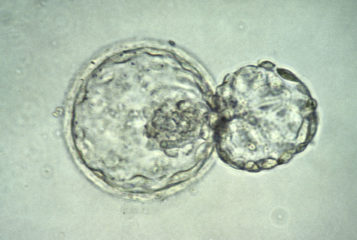US scientists claim that they have developed a new technique for creating patient-matched embryonic stem (ES) cells, which does not involve 'therapeutic cloning'. Yuri Verlinsky, of the Reproductive Genetics Institute in Chicago, unveiled the new method at the recent Sixth International Symposium on Preimplantation Genetic Diagnosis, held in London. However, news of the novel cells, dubbed 'stembrids', has been greeted with scepticism by other stem cell researchers.
Last week, a South Korean team published a groundbreaking study that described the creation of new ES cell-lines genetically identical to 11 patients affected by spinal injury or illness. They did this by replacing the genetic material of an unfertilised egg with that of a skin cell from the patient, using an approach called somatic cell nuclear transfer. Many scientists think that research on cells created in this way could lead to new treatments for a range of diseases. However, it is currently banned or restricted in many countries, since it involves the destruction of human embryos. Now, Verlinksy says he has come up with a way to create such cells using existing human ES cell lines. He claims that his team has already produced 10 cell lines using the new stembrid approach, although the work has not yet been published.
According to a report in last week's New Scientist magazine, the new method involves removing the nuclei (which contains the genetic information) of ES cells by spinning them in a centrifuge. The team then takes cells from adult patients, and fuses them with the enucleated ES cells, a process that turns the fused cell into an ES cell. Verlinsky says that like true ES cells, the stembrid cells can produce a range of different body tissues, and has already shown that they can grow into heart muscle, nerve and blood stem cells. He also says that the stembrid cells have protein 'markers' typical of ES cells.
But according to Australian stem cell expert Alan Trounson, far more detailed studies are needed to prove that the new cells are true ES cells. 'Until they have done these studies, we must remain very sceptical', he said. UK embryologist Marilyn Monk agreed, saying 'it just seems too easy'. Verlinsky has applied for a patent on the stembrid method, but assured delegates at the meeting that 'I have not done it so I can charge you, I have done it so no-one else can charge me'.
If stembrid cells really are a true alternative to ES cells, then they could solve a potential problem with this research, highlighted after the South Korean announcement. Woo Suk Hwang and his colleagues say the key to their success was using fresh eggs from young, fertile women, rather than eggs left over from fertility treatment. However, there is already a lack of donated eggs for treating infertility, and this shortage could also hold up ES cell research in the UK and other countries aiming to repeat the Korean team's achievement.
Sources and References
-
US team may have trumped stem cell breakthrough
-
Double triumph in stem cell quest
-
Stem cells 'could be made without embryo cloning'




Leave a Reply
You must be logged in to post a comment.